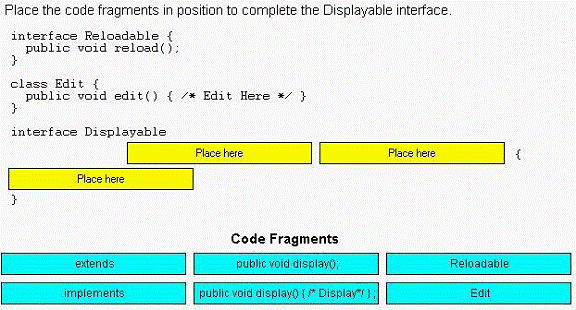1. Language Fundamentals
Q: 11 Click the Task button.

Solution:
interface Reloadable{
public void reload();
}
class Edit{
public void edit(){/* Edit Here*/}
}
interface Displayable
extends Reloadable {
public void display();
}
Q:12 Given:
35. String #name = "Jane Doe";
36. int $age = 24;
37. Double _height = 123.5;
38. double ~temp = 37.5;
Which two statements are true? (Choose two.)
A. Line 35 will not compile.
B. Line 36 will not compile.
C. Line 37 will not compile.
D. Line 38 will not compile.
Answer: A, D
Q: 13 Given:
55. int [] x = {1, 2, 3, 4, 5};
56. int y[] = x;
57. System.out.println(y[2]);
Which statement is true?
A. Line 57 will print the value 2.
B. Line 57 will print the value 3.
C. Compilation will fail because of an error in line 55.
D. Compilation will fail because of an error in line 56.
Answer: B
Q: 14
A programmer needs to create a logging method that can accept an
arbitrary number of arguments. For example, it may be called in these ways:
logIt("log message1");
logIt("log message2","log message3");
logIt("log message4","log message5","log message6");
Which declaration satisfies this requirement?
A. public void logIt(String * msgs)
B. public void logIt(String [] msgs)
C. public void logIt(String... msgs)
D. public void logIt(String msg1, String msg2, String msg3)
Answer: C
Q: 15
Which two code fragments correctly create and initialize a static array of int
elements? (Choose two.)
A. static final int[] a = { 100,200 };
B. static final int[] a;
static { a=new int[2]; a[0]=100; a[1]=200; }
C. static final int[] a = new int[2]{ 100,200 };
D. static final int[] a;
static void init() { a = new int[3]; a[0]=100; a[1]=200; }
Answer: A, B
Q: 16 Given:
11. public static void main(String[] args) {
12. String str = "null";
13. if (str == null) {
14. System.out.println("null");
15. } else (str.length() == 0) {
16. System.out.println("zero");
17. } else {
18. System.out.println("some");
19. }
20. }
What is the result?
A. null
B. zero
C. some
D. Compilation fails.
E. An exception is thrown at runtime.
Answer: D
Q: 17 Click the Exhibit button.
Given:
34. Test t = new Test();
35. t.method(5);
What is the output from line 5 of the Test class?

A. 5
B. 10
C. 12
D. 17
E. 24 Answer: B
Q: 18 Given
11. public interface Status {
12. /* insert code here */ int MY_VALUE = 10;
13. }
Which three are valid on line 12? (Choose three.)
A. final
B. static
C. native
D. public
E. private
F. abstract
G. protected
Answer: A, B, D
Question: 19
A programmer is designing a class to encapsulate the information
about an inventory item. A JavaBeans component is needed to
do this. The Inventoryltem class has private instance variables to store
the item information:
10. private int itemId;
11. private String name;
12. private String description;
Which method signature follows the JavaBeans naming standards for
modifying the itemld instance variable?
A. itemID(int itemId)
B. update(int itemId)
C. setItemId(int itemId)
D. mutateItemId(int itemId)
E. updateItemID(int itemId)
Answer: C